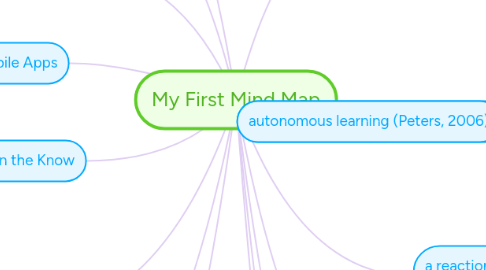
1. beginning of asynchronous teaching and learning (printed means) (Peters, 2006)
2. technology-based but different pedagogies and media structures (Peters, 2006)
3. Mind Map Training
3.1. Visit the MindMeister Academy to learn all the tricks and become a great mapper in no time!
4. Tutorial Videos
4.1. With our short tutorial videos you can get to know MindMeister's most important features in a matter of minutes
5. Key Shortcuts
5.1. To view the most important shortcuts, click on the question mark in the bottom right corner of your map editor, then click "Key Shortcuts"
6. Mobile Apps
6.1. Download our native mobile apps for iOS and Android to mind map on the go!
7. Stay in the Know
7.1. Follow our blog to never miss an important update, downtime warning or tutorial!
8. Open universities and growing demand (Peters, 2006)
8.1. technology-based but different pedagogies and media structures (Peters, 2006)
8.2. growing adult student population (Peters, 2006)
8.3. single and dual-mode universities (Peters, 2006)
8.4. a reaction to the elitist university system (Haughey, 2010)
9. DE - pre-1970 (Haughey, 2010)
10. By the way, this is a floating topic. To create a floating topic, simply drag it away from the map center.
11. Getting started
11.1. Add a sibling idea by hitting ENTER
11.2. This is a sibling idea
11.3. Add a child idea by hitting TAB
11.3.1. This is a child idea
11.4. Choose icons and images to decorate your mind map
11.5. Connect topics with the arrow tool in the upper left corner of your screen
11.6. Add links, tasks or files to your topics, using the widgets in the sidebar
11.7. Change your map layout by opening the layout options in the upper left corner of your screen
11.8. Advanced
11.8.1. Open the Theme menu from the bottom of your map editor to change your map theme
11.8.2. Create a presentation of your mind map by clicking the presentation icon in the bottom left corner of your screen
11.8.2.1. Simply hold down COMMAND i.e. CTRL and Click & Drag to create a slide for one or multiple topics
11.8.2.2. Set transitions for your slides
11.8.2.3. Click "Start Slideshow" to view your presentation
11.8.3. Open the Sharing Settings from the bottom of your map editor to share the map with a friend or publish it to the web
11.8.3.1. You can share your map with anyone via email
11.8.3.2. You can publish your map and enable anyone with an internet access to find it
11.8.3.3. You can embed your map on a blog or website
